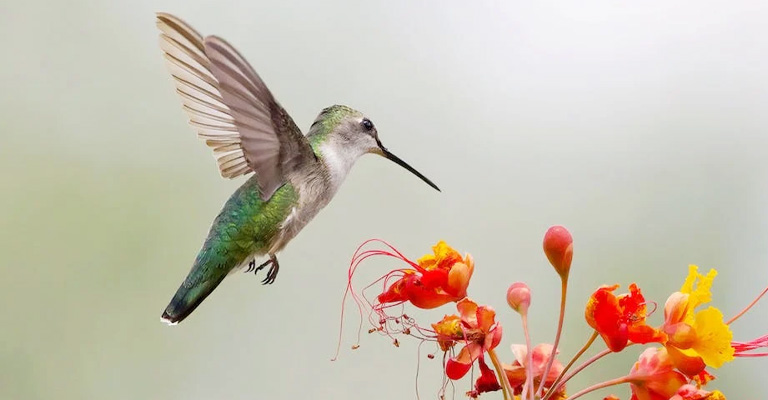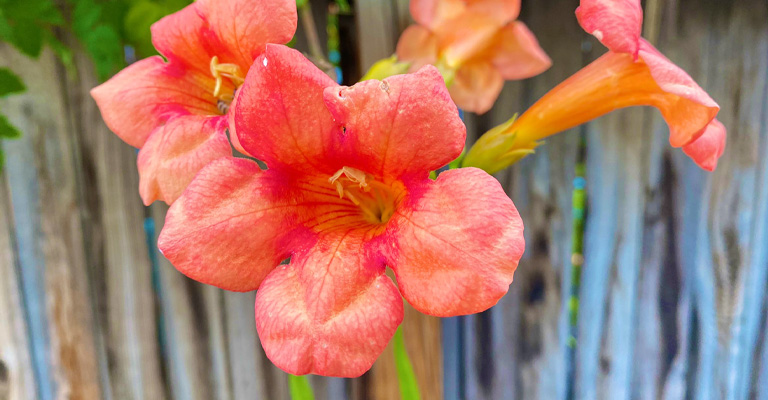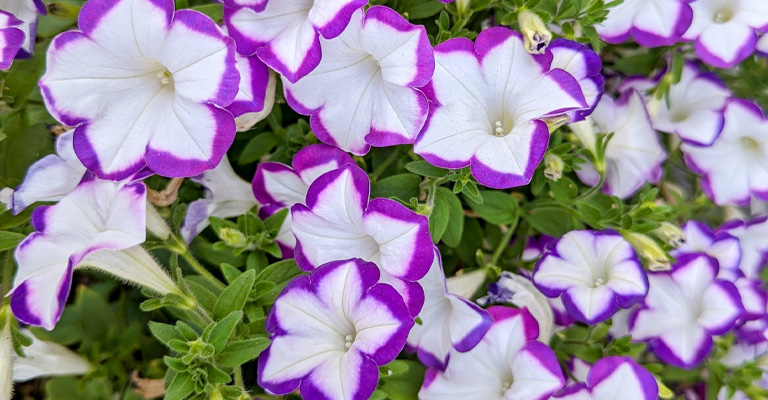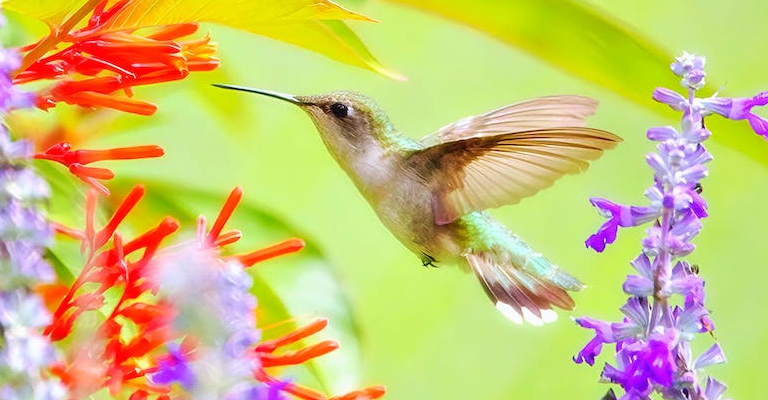Imagine stepping into your garden on a balmy summer morning, surrounded by a riot of colors and the delightful buzz of hummingbird wings.
By strategically choosing hanging plants that not only beautify your outdoor space but also attract hummingbirds, you can transform your garden into a vibrant sanctuary. So, what are some glorious hanging plants to attract hummingbirds?
In this guide, we’ll take you on a journey through the world of hanging plants that serve as irresistible magnets for hummingbirds.
We’ll introduce you to a stunning array of flora, from cascading blooms to lush foliage, each with its unique charm and appeal to these tiny, agile birds.
Whether you’re an experienced gardener or a novice, you’ll find inspiration and practical tips to cultivate your own hummingbird paradise. So, grab your gardening gloves and get ready to welcome these delightful aerial acrobats into your outdoor oasis.

Glorious Hanging Plants to Attract Hummingbirds
When it comes to creating a vibrant and enchanting garden, few creatures are as captivating as hummingbirds. These tiny, iridescent birds with their rapid wingbeats and aerial acrobatics bring a touch of magic to any outdoor space.
Let’s explore a selection of glorious hanging plants that will turn your garden into a hummingbird haven.
Fuchsia (Fuchsia spp.)
Few plants can match the sheer elegance and allure of fuchsia. With pendulous, tubular flowers that come in various shades of pink, purple, and red, fuchsia is a hummingbird favorite.
These vibrant blooms hang gracefully from the stems, making them a perfect choice for hanging baskets or planters. Hummingbirds are irresistibly drawn to fuchsia’s abundant nectar, and their visits turn your garden into a lively spectacle.
Bleeding Heart (Dicentra spectabilis)
The bleeding heart plant is aptly named, with its unique, heart-shaped flowers in shades of pink and white. While the name may sound melancholic, there’s nothing sad about the cheerful presence of hummingbirds it attracts.
The distinct shape of the flowers provides the perfect perch for these agile birds, and they gladly sip nectar from each bloom, adding a touch of whimsy to your garden.
Trumpet Vine (Campsis radicans)

If you’re looking for a robust, low-maintenance plant to draw hummingbirds, the trumpet vine is an excellent choice. With its trumpet-shaped, fiery orange or red blossoms, this plant stands out from a distance.
Hummingbirds can’t resist the bountiful nectar inside these flowers. The trumpet vine is known for its vigorous growth, so be prepared to provide ample space and support for this exuberant climber.
Mandevilla (Mandevilla spp.)
Mandevilla, with its striking trumpet-shaped flowers in shades of red, pink, or white, is another hummingbird magnet. This tropical vine thrives in warm climates and is often grown in hanging containers.
Its large, showy flowers are like a welcome sign for hummingbirds, inviting them to sip on the sweet nectar within. With proper care, your mandevilla will reward you with a continuous display of blooms throughout the growing season.
Lobelia (Lobelia spp.)
Lobelia’s delicate, cascading blooms are a visual treat, and they serve as a delectable buffet for hummingbirds. These plants come in various shades of blue, purple, and red, making them a versatile addition to your garden.
Whether you choose the trailing or upright varieties, lobelia’s profusion of small, tubular flowers is sure to attract hummingbirds and other pollinators.
Petunia (Petunia spp.)

Petunias are among the most popular annual flowering plants, and they’re a favorite of hummingbirds too. These trumpet-shaped flowers, available in a wide range of colors, produce an abundance of nectar.
Plant petunias in hanging containers or window boxes, and watch as hummingbirds visit your garden frequently to enjoy the sweet treat these vibrant blooms offer.
Salvia (Salvia spp.)
Salvia, often referred to as sage, encompasses a diverse group of plants known for their spiky, tubular flowers. The scarlet sage (Salvia coccinea) and the red hot poker sage (Salvia uvaria) are particularly attractive to hummingbirds.
With their fiery, red-colored flowers, these salvias create a bold and striking focal point in your garden, and they provide a rich source of nectar for hummingbirds to enjoy.
Columbine (Aquilegia spp.)
Columbine plants feature intricate, bell-shaped flowers in various colors, making them a unique addition to any garden. These blooms serve as a delightful stopover for hummingbirds as they search for nectar.
The combination of columbine’s distinct shape and vibrant hues makes it a must-have for gardeners looking to entice these charming birds.
Bee Balm (Monarda spp.)

Bee balm, also known as wild bergamot, features vibrant, clustered flowers in shades of red, pink, or purple. This plant is not only a favorite of bees but also of hummingbirds.
The tubular shape of bee balm flowers is tailored to hummingbird feeding, and the sweet nectar within is irresistible to them. Plant different varieties of bee balm to ensure a continuous supply of nectar-rich blooms in your garden.
Lantana (Lantana camara)
Lantana is a beautiful, low-maintenance plant that hummingbirds find irresistible. It produces clusters of small, tubular flowers that come in a striking array of colors, including shades of red, orange, and yellow.
The profuse blooms of lantana provide a reliable source of nectar. This plant is also known for its ability to attract butterflies, making it a double bonus for your garden’s wildlife appeal.
By introducing these plants to your garden, you enhance the diversity of nectar-producing plants, further attracting hummingbirds.
The varied colors and shapes of these plants add visual interest to your garden and make it a vibrant oasis for both you and these tiny aerial acrobats.
How to Attract Hummingbirds to Your Hanging Plants?

Attracting hummingbirds to your hanging plants is a delightful endeavor that can be achieved with some dedicated effort and a few key strategies.
To make your garden a haven for these tiny marvels, you need to consider several factors that extend beyond the mere selection of plants.
Here, we’ll delve into how to attract hummingbirds to your hanging plants by offering them a comfortable and nourishing environment.
Provide Shelter
Hummingbirds not only seek sustenance but also need a safe haven for rest and nesting. Trees and shrubs are excellent additions to your garden as they provide protection and potential nesting sites. A lush, well-vegetated area offers a sense of security that hummingbirds appreciate.
Regular Pruning
Hanging plants need to be well-maintained to keep hummingbirds coming back. Prune away any dead or spent flowers from your plants.
This practice encourages more blooms and, consequently, more nectar production, making your garden more attractive to hummingbirds.
Nectar Feeders
Hummingbird feeders can be a valuable addition to your garden. These feeders mimic the shape and color of flowers, making it easy for hummingbirds to spot them.
By filling these feeders with sugar water, you provide a readily available source of nectar, especially during periods when natural nectar sources may be scarce.
Water Features
Install a small water feature like a birdbath or fountain in your garden. Hummingbirds not only need nectar but also water for drinking and bathing.
Providing a clean water source can enhance their stay in your garden, making it even more attractive to these enchanting birds.
Avoid Pesticides
Minimize the use of pesticides in your garden. These chemicals can harm not only the hummingbirds but also the insects they rely on for food.
An abundance of insects in your garden provides natural foraging opportunities for hummingbirds, so it’s essential to maintain a balanced ecosystem.
Year-Round Interest
Opt for a variety of hanging plants that bloom at different times of the year. This ensures a continuous and diverse food source for hummingbirds.
By providing a consistent supply of nectar-rich blooms, you’ll make your garden a reliable destination for these delightful visitors.
By incorporating these practices into your gardening routine, you not only create an attractive environment for hummingbirds but also contribute to their well-being.
Your garden becomes a place where these marvelous birds can feed, rest, and even nest. It’s a win-win situation where you get to enjoy the company of these captivating creatures, and they, in turn, benefit from the care you invest in your garden.
FAQs
How can I make hummingbird nectar for my feeders?
To make hummingbird nectar, mix one part of white granulated sugar with four parts of boiling water. Stir until the sugar dissolves completely, and let the mixture cool before filling your feeder. Avoid using honey, brown sugar, or artificial sweeteners, as these can harm hummingbirds.
How do I keep ants away from my hummingbird feeders?
To deter ants from climbing on your hummingbird feeders, apply a barrier of food-grade diatomaceous earth or use ant moats. Ant moats are small cups that attach above the feeder, and when filled with water, create a barrier that ants cannot cross.
What are some hummingbird-friendly flowering shrubs?
Hummingbird-friendly shrubs include trumpet vine, weigela, butterfly bush, and fuchsia. These shrubs produce tubular flowers that are ideal for hummingbirds to feed from.
How do I clean my hummingbird feeder?
It’s important to regularly clean your hummingbird feeder to prevent mold and bacterial growth. Disassemble the feeder, wash all parts with hot, soapy water, and use a bottle brush to clean narrow openings. Rinse thoroughly and refill with fresh nectar.
When is the best time to attract hummingbirds to my garden?
Hummingbirds migrate, so the best time to attract them to your garden depends on your location. In North America, they typically arrive in the spring, and it’s a good idea to have your feeders and plants ready by early spring to welcome them as they return from their migration south.
Conclusion
By selecting the right hanging plants, you can create a haven for hummingbirds in your garden. These glorious aerial acrobats will reward your efforts with their vivid presence and mesmerizing displays.
Creating a haven for these enchanting creatures is easier than you might think. Hummingbirds are remarkable creatures known for their vibrant colors and graceful flight.
From the vibrant fuchsia of the fuchsia plant to the pendulous beauty of the bleeding heart, your garden can become a hummingbird paradise.
Remember to provide a hospitable environment with nectar-rich blooms, adequate sunlight, and shelter. With a little care and attention, you’ll witness these tiny marvels of nature darting and hovering amidst your hanging plants, bringing joy and wonder to your outdoor space.
So, embrace the charm of these glorious hanging plants, and let your garden flourish with the mesmerizing beauty of hummingbirds. Happy gardening!